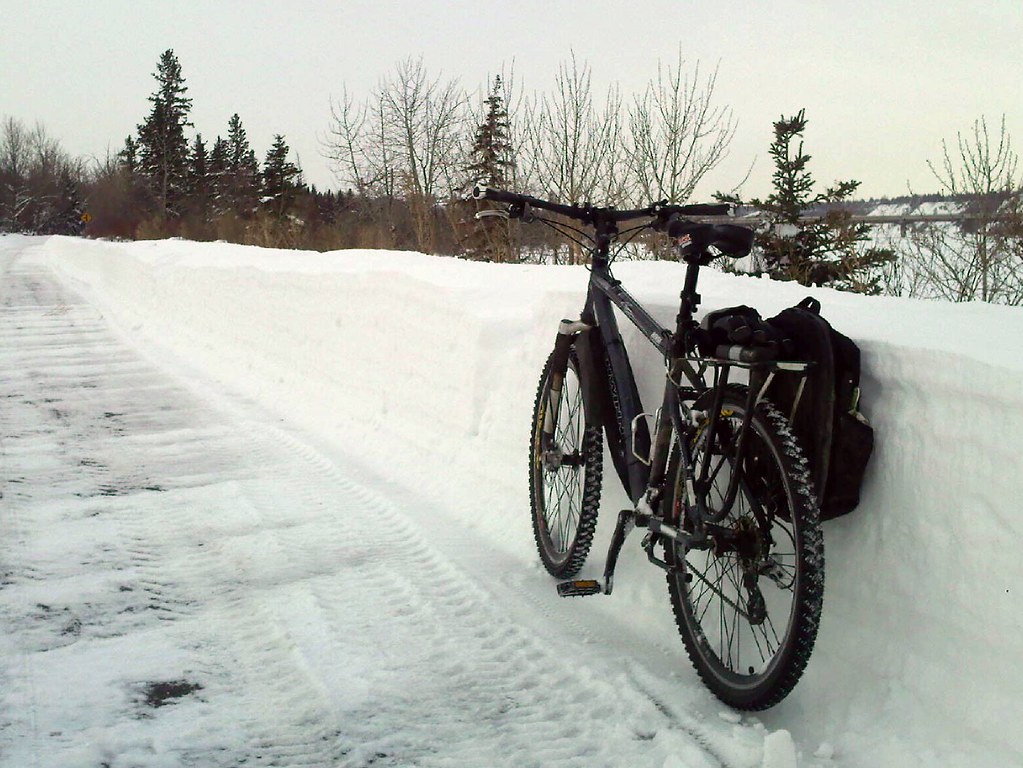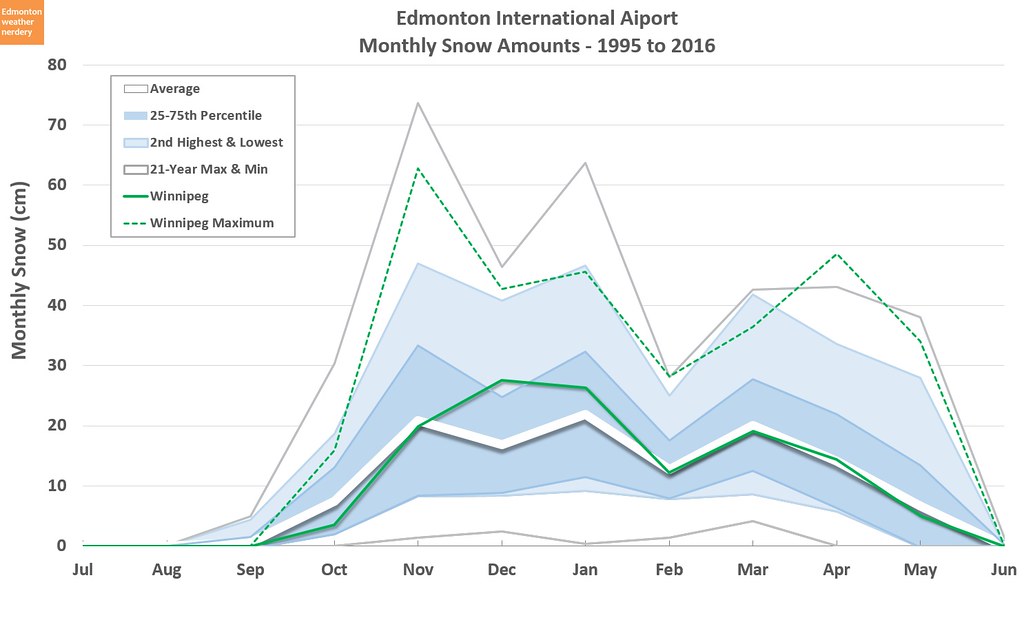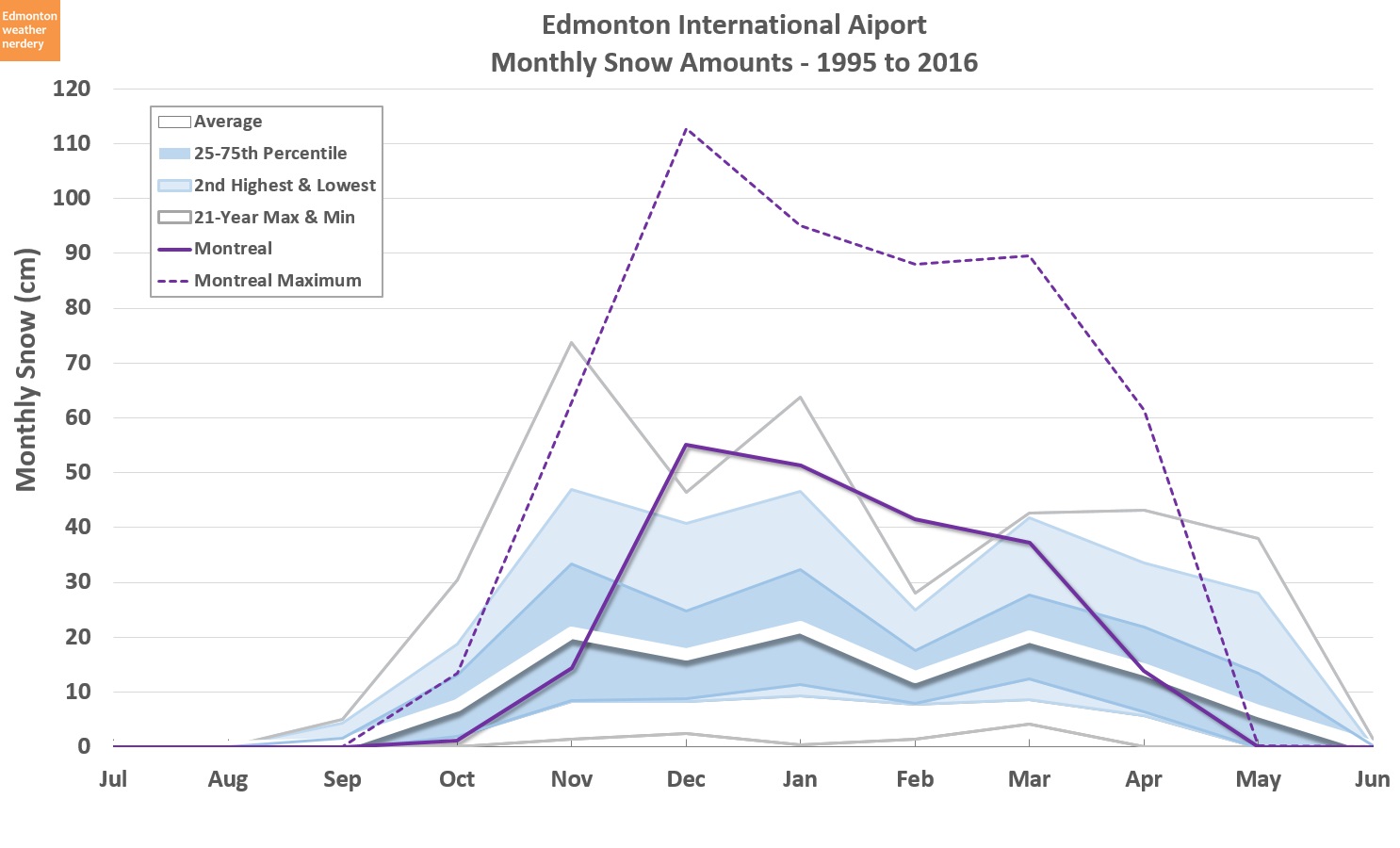But today we are going to look at when during the winter we usually get snow. This is Part 4 of the recent look at Edmonton snowfall:
We'll start off with how likely we are to get snow in each of the months of the year:
This shows the chances of each month getting at least one day with some snow, based on recent history. So this isn't saying that November through March are 100% all-snow-all-the-time, but just that in every year since 1995 there has been some snow in those months. This includes anything greater than 0.1cm, so in some cases this could have been a dusting that was barely noticeable.
The numbers for November through March aren't very surprising, so here I'm more interested in the shoulder-season months. September snow is pretty rare, but then an October that is snowfree is pretty unlikely. And skipping forward to the spring, a snowfree April is extremely unlikely, while May will get snow a bit more than half of the time.
So in a typical year our snow-season will last from roughly October through April, and maybe into May.
Next we'll look at the number of days each month when the sidewalks might need to be shoveled:
Number of Snowdays
This chart shows the number of days each month with snowfall. It follows my favourite format: a line for the average is in the middle; which is surrounded by the 25th to 75th percentiles; then the second highest and second lowest; and then the highest and lowest recorded since 1995. And again this is counting any day with more than 0.1cm of snow.
The "real" winter months - November through March - have a pretty consistent average around the 8 or 9 day mark. But some years there is a lot more shoveling, with the maximum for each of those months in the 15 to 20 day range. And as we saw in the previous chart, since 1995 there's been at least one day of snow in every month from November through March.
The shoulder-season months are on average a lot lower, with October, April and May at around 2 to 4 snowfalls. But those months can be snowy too, reaching 8 or 9 days in some years.
That is how often we get snowfall, and next we'll look at how much snow we actually get:
Monthly Totals
Here we have the monthly distribution of snowfall amounts.
In terms of average snowfall we can see that November, December, January and March are all pretty similar at around 20cm per month. February is on the low side for the winter at around 15mm, which is about the same as April. And then October and May both average below 10cm.
In October 2016 we received 22cm, which is well above the average for October. This year was the second snowiest October since 1995, coming in below the 30cm that fell in October of 2004.
The 20cm average for most the winter months isn't very much when it's spread across a whole month with 8 or 9 snowfalls. But looking at the maxes, we have had some extremes like 74cm in November 1996, and 64cm in January 2011.
I've mentioned January 2011 before, because it was my second winter cycling to work, and the only time I've seen anything even close to this:
I rode that whole month, and things worked okay, but I'm glad we don't see that very often.
For a little bit more context, lets see how Edmonton's snow compares to some other cities.
Here is Calgary, in red:
Calgary
Through January, the winters in Edmonton and Calgary are pretty similar at around 20cm per month. But then in March, April and May Calgary's averages jump up to 5cm or 10cm more than Edmonton.
In terms of the snowiest months since 1995, Calgary's highest have been below Edmonton's in the early part of the winter. But then Calgary has had a snowier February, March and April. And those very snowy months are part of the reason why Calgary's March-May averages are higher than Edmonton's.
For another comparison, here is Winnipeg in green:
Winnipeg
This Winnipeg data is a bit problematic, because after 2007 they stopped recording snowfall (which is the same time that Blatchford's precipitation data became unreliable). So this is a comparison of 13 years of data from the Winnipeg International against 21 years from the Edmonton International. That is not ideal, but it's what I've got.
With this somewhat flawed comparison, Winnipeg looks pretty similar to Edmonton. The averages for November, February, March, April and May are almost a perfect match for the two cities. But December and January are on average a bit higher in Winnipeg.
In terms of the snowiest months recorded since 1995, Edmonton's are mostly higher than Winnipeg's. But since Winnipeg is only pulling from a pool of 13 winters, there is certainly room for error there.
Finally, here is Montreal in purple:
Montreal
Montreal's data is also a little flawed because the snowfall records for the Pierre Elliot Trudeau airport stopped after 2012. So in this case we have 18 years of Montreal data versus 21 for Edmonton.
With this graph the scale has had to change, because Montreal is in a different league from Edmonton, Calgary and Winnipeg. So here the Edmonton data is squished down a little bit.
For most of the winter Edmonton averages around 20cm per month, but Montreal is in the 40cm to 60cm range. That places Montreal's average fairly close to Edmonton's very snowiest months. And looking at Montreal's snowiest months, in several cases they are about double Edmonton's.
Bringing it all together, here are the averages for all of the cities combined:
This chart is a little busy, but we can see that the three prairie cities are quite similar to one another, especially compared to Montreal.
While Montreal's snowy months are very snowy, its season is much shorter. In Edmonton and Calgary the snow starts in about October and lasts through May, but in Montreal it really only stretches from November through April.
When all of those months are added up for yearly totals, Edmonton averages about 130cm, Calgary about 150cm, Winnipeg about 130cm, and Montreal about 210cm.
So today we've seen when during the year the snow actually falls. And in previous posts we've looked at when the snow starts, and at how much snow we get in a year. There's still one more chapter in this story, and next time we'll take a closer look at snowfall events, and at how often Edmonton gets giant snowstorms versus gentle dustings.









No comments:
Post a Comment